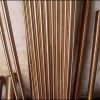
Molybdenum-copper alloy has high thermal conductivity, up to about 200W/(m·K), and has the advantages of small thermal expansion coefficient and easy machining. It is used in spacecraft phased array antenna T/R module bottom plate and high-power microwave shell And power device carriers and other fields have good application prospects. However, the surface wettability of molybdenum-copper alloys is poor, which cannot meet the welding function requirements of PbSnAg, SnAgCu and AuSn solders. In order to improve the surface solderability of molybdenum-copper alloys, it is necessary to prepare a gold plating layer with excellent welding performance on the surface. The surface composition of the alloy is composed of two metal elements with relatively different chemical properties, element M0 and element Cu, and the content of the chemically inert Mo element is as high as 85%, which makes the preparation of gold coating on the surface difficult. In aerospace products , The solders used in the early days are mainly PbSnAg, InSn, etc., the peak temperature of the low melting point solder during the soldering process is below 230 ℃, so the high temperature resistance of the gold plating is lower.
With the development of T/R module housing and chip packaging technologies, high melting point solders represented by AnSn are widely used, and their peak soldering temperature is as high as 300℃. During the high-temperature soldering process, the gold plating layer and the molybdenum copper alloy substrate are thermally expanded. The thermal stress caused by the coefficient mismatch increases, which leads to quality problems such as skinning and blistering of the gold coating. Therefore, in order to meet the welding requirements of the spacecraft stand-alone load product, the preparation and high temperature resistance of the gold coating on the surface of the molybdenum copper alloy Put forward higher requirements
Preparation of Molybdenum Copper Alloy Gold Coating
- 1. The specific chemical composition (mass fraction, %) of the molybdenum copper alloy material used in the test: Cu15.0±3.0, Ni2.2±0.5, impurity element ≤0.1, Mo balance.
- 2. The main process flow of molybdenum copper alloy gold plating: molybdenum copper alloy test piece → degreasing → chemical roughening → displacement plating → chemical nickel plating → gold plating.
- 3. Chemical roughening adopts anodic etching, in a 98% (mass fraction) sulfuric acid solution system, at a current density of 0.3~0.5A/dm2, anode constant current for 5~10min. The displacement plating uses a palladium salt solution (0.1~0.8g/L palladium chloride, 20mL/L hydrochloric acid), and the molybdenum copper alloy substrate is soaked for 1 to 2 minutes at room temperature. Electroless nickel plating adopts a conventional solution system with nickel sulfate as the main salt, the composition is 25g/L nickel sulfate, 30g/L sodium hypophosphite, 15g/L sodium citrate, 10g/L sodium acetate, 8mL/L brightener , 0.5mg/L thiourea; the solution temperature is 80℃, and the plating time is 20-30min. The gold plating adopts the cyanide gold plating solution system, and the current density of 0.1~0.2A/dm2 is used for 15min at room temperature. The composition of the cyanide gold plating solution: 10~12g/L potassium aurous cyanide, 30~40g /L Free potassium cyanide.
- 4. The chemicals used in the test are of analytical grade, and the solution preparation uses double distilled water. 1.2 Test and Characterization The size of the test sample is 30mm×30mm×2mm, the thickness of the electroless nickel coating on the sample surface is 3~5μm, of which the content of P element is about 8%, the thickness of the gold coating is 1~2μm, and its purity is ≥99.9% . The analyzer analyzes the microscopic morphology and elemental composition of the Mo-Cu alloy substrate and coating, and uses gold-tin welding to verify the welding performance of the coating on the surface of the sample.
- 5. The high temperature resistance of the gold coating on the surface of the molybdenum copper alloy is tested according to the baking test method: After the coating is kept at 350℃ for ≥5min, observe whether there are quality problems such as skinning and blistering.
Influence of displacement plating on the morphology and composition of Mo-Cu alloy
The chemical properties of element Mo and element Cu at the interface of the molybdenum copper alloy substrate are quite different, resulting in different surface chemical activities of different elements in the subsequent crystal deposition process, resulting in differences in deposition speed and deposition orientation, which in turn leads to greater internal stress in the coating , In the follow-up high temperature welding process, the coating has adhesion problems due to the release of internal stress. In order to avoid the problem of coating adhesion caused by the different chemical properties of dissimilar elements on the surface of the substrate, displacement plating technology is used to achieve the uniformization of the chemical properties of dissimilar elements on the surface of the molybdenum-copper alloy, that is, the element Mo and element Cu at the substrate interface are respectively and The activator undergoes a displacement reaction, thereby forming an activation point with uniform chemical properties at the interface of the substrate.
After displacement plating, the interface elements at the molybdenum-copper alloy substrate are converted from Mo and Cu into uniform activating elements Pd. This element has a certain catalytic activity for the electroless nickel plating reaction, and due to the uniform element composition at the interface, the subsequent electroless plating is guaranteed The uniform deposition of the Ni-P alloy coating during the nickel process can effectively reduce the coating stress and ensure the bonding force of the coating.
The effect of surface roughening of Mo-Cu alloy substrate
The thermal expansion coefficient of the Mo-Cu alloy substrate is relatively low, and the thermal expansion coefficient of the gold coating is large. Therefore, the internal stress caused by the mismatch of the thermal expansion coefficient of the substrate and the coating is the main reason for the poor high temperature resistance of the coating. When the thermal expansion coefficient of the molybdenum-copper alloy substrate and coating is determined by its intrinsic physical properties of 0.5g/L, the surface of the substrate is dark black after displacement plating, and the subsequent Ni-P alloy deposition rate is faster and the solution is stable It is better, indicating that the number of active points prepared is more appropriate, which is beneficial to the preparation of the Ni-P underplating layer; (4) When the palladium salt concentration is greater than or equal to 0.5g/L, the color of the substrate after replacement plating is dark black, and the subsequent Ni-P The deposition rate of P alloy is faster, and the solution is easy to decompose, indicating that the number of active points prepared is too much, resulting in strong catalytic activity on the surface of the substrate, and it is easy to cause the problem of shorter solution life, which is not conducive to the Ni-P alloy underplating layer. preparation.
Therefore, the optimum range of palladium salt concentration is 0.3~0.5g/L
High temperature resistance and welding performance of gold plating
The high temperature resistance test results of the gold coating show that after the high temperature baking test, the obtained gold coating has no quality problems such as peeling and blistering, which meets the technical index requirements. The welding performance test results of the gold plating on the surface of the molybdenum-copper alloy show that the solder has good wettability on the surface of the gold-plated molybdenum-copper alloy. X-ray inspection is used after the welding is completed. The void rate is ≤30%, which meets the requirements of welding technical indicators.
Preparation of gold-plated molybdenum-copper alloy and conclusion on high temperature resistance and welding performance
Through chemical roughening, the specific surface area of the molybdenum copper alloy substrate is increased, and the bonding strength between the plating layer and the molybdenum copper alloy substrate is increased. In view of the completely different chemical properties of elemental Mo and elemental Cu on the surface of the molybdenum-copper alloy, displacement plating is used to achieve the uniformity of the chemical properties of dissimilar elements on the surface of the substrate. After the final gold plating on the surface of the molybdenum copper alloy is tested by the baking test method in GJB1941-94 “Gold Electroplating Specification”, it can withstand high temperature baking at ≥350℃. The solder has good wettability on the surface of the gold-plated molybdenum-copper alloy. After the soldering is completed, the void rate is tested by X-ray. The void rate is ≤30%, which meets the requirements of welding technical indicators.






